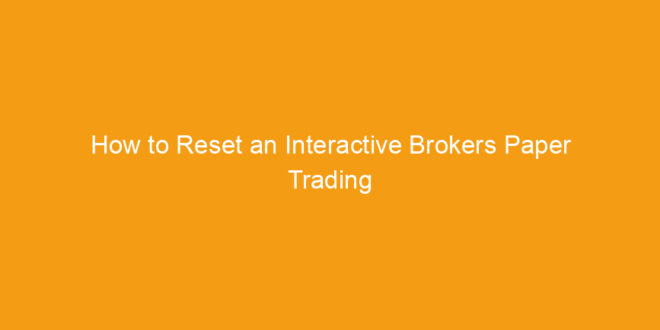Trading in a paper trading account with Interactive Brokers (IB) is a great way to practice and gain confidence in your trading skills without risking any real money. However, sometimes you may want to reset your paper trading account and start from scratch. Fortunately, IB makes it easy to reset your paper trading account, allowing you to begin again with a clean slate.
To reset your paper trading account, simply log into your IB account. Then, click on the “My Account” tab at the top of the screen. From there, select the “Paper Trading” tab. On the Paper Trading page, click on the “Reset Paper Trading Account” button. You will then be given the option to reset your account with either a “Full Reset” or a “Partial Reset”. A full reset will clear all of your account data, transactions, and positions, and start you over with a new account. A partial reset will clear all of your positions, but will keep your account data and transactions intact.
Once you have selected the type of reset you would like to perform, click the “Reset Paper Trading Account” button. Your account will then be reset, and you can begin again with a clean slate.
It is important to remember that your reset paper trading account will have the same username and password as your existing account. Therefore, it is important to keep your username and password secure and not share them with anyone.
Resetting your Interactive Brokers paper trading account is a quick and easy process that can be done in just a few minutes. By resetting your paper trading account, you can practice and gain confidence in your trading skills without risking real money.
Exploring the Benefits of a Paper Trading Account with Interactive Brokers
Paper trading is an invaluable tool for traders of all levels of experience to practice strategies, test theories, and gain familiarity with different trading platforms without risking any capital. For those who are serious about trading, Interactive Brokers’ paper trading account provides access to real-time streaming data and a fully-integrated trading platform.
Paper trading with Interactive Brokers gives traders the opportunity to learn the intricacies of the platform in a simulated environment, allowing them to make the same trades as if they were using a live account. This allows traders to experiment with different strategies, develop their own trading style, and become familiar with the platform before risking their capital.
In addition to the ability to practice trading strategies, Interactive Brokers’ paper trading account also offers access to real-time market data. This allows traders to access real-time quotes, analyze stocks, and track their performance in the same way they would in a live account. With Interactive Brokers’ paper trading account, traders can also view their order history and track the profitability of their trades.
Further, Interactive Brokers’ paper trading account is integrated with the same tools and resources as their live accounts. This includes access to trading calculators to help traders calculate profit and loss, margin requirements, and commissions. Additionally, traders can use the IB Risk Navigator to analyze their trades and optimize risk/reward ratios.
Overall, Interactive Brokers’ paper trading account is an invaluable tool for any trader looking to practice their strategies and gain familiarity with the platform without risking their capital. With access to real-time streaming data and a fully integrated platform, traders can gain the confidence to take their trading to the next level.
A Guide to Understanding the Risks of Paper Trading with Interactive Brokers
Paper trading is a popular way for investors to practice their skills and explore new strategies without risking any of their own capital. Many brokerages, such as Interactive Brokers, offer paper trading accounts to their customers, allowing them to simulate real-world trading scenarios with virtual funds. While paper trading can be an invaluable tool for learning, it comes with its own set of risks that should not be overlooked.
One of the primary risks associated with paper trading is the risk of developing bad habits. When trading with virtual funds, investors may be more prone to taking excessive risks or trading on impulse. This can lead to poor decision-making and a lack of discipline when trading with real money, potentially resulting in significant losses.
Another risk associated with paper trading is the potential for inaccurate data. Paper trading accounts use simulated market data, which may not accurately reflect real-world conditions. For example, simulated market data may not reflect the same liquidity or pricing as live execution. As a result, any strategies tested using paper trading data may not be as successful in real-world trading.
Finally, there is the risk of overconfidence. When trading with virtual funds, there is no real money at stake, which can lead to a false sense of security. Investors may become overly confident in their abilities and start taking on more risk than they can safely handle. This can lead to significant losses when trading with real money.
Overall, paper trading can be an invaluable tool for learning and exploring new strategies, but investors should be aware of the risks associated with it. By understanding the risks and staying disciplined, investors can make the most out of their paper trading experience.

